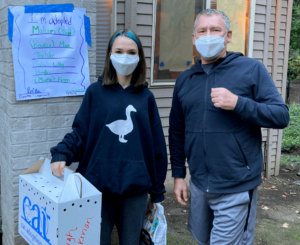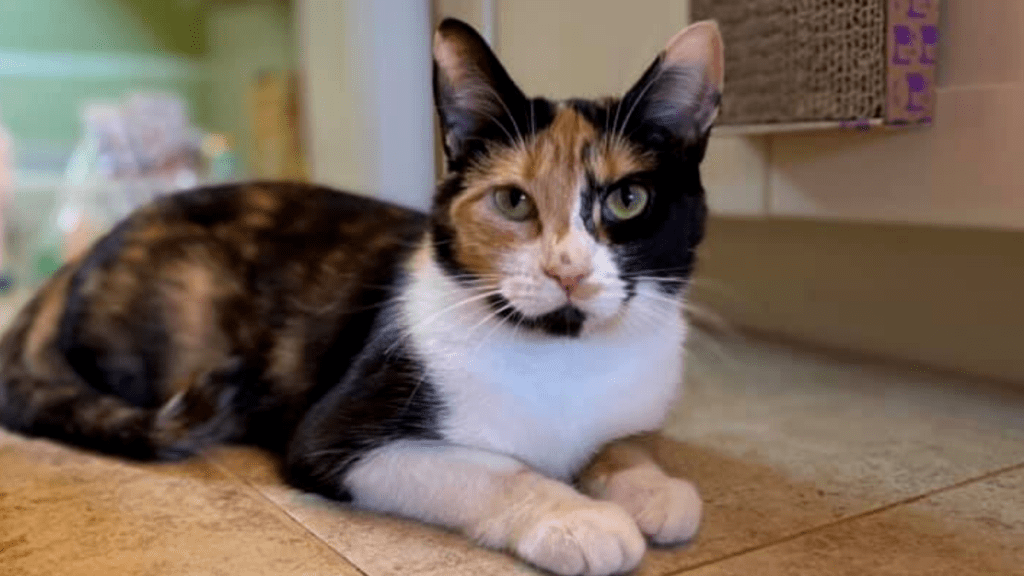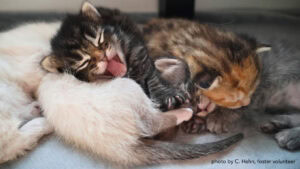When the COVID-19 pandemic hit, Cat Adoption Team (CAT), like many organizations, made quick changes to adapt. This included closing the shelter to the public and housing many more of our cats and kittens in foster homes. After suspending adoptions for a brief period, this vital service resumed in early April 2020 with a new virtual adoption process and contactless pick-up from both the shelter and foster homes.
Although moving to virtual adoptions was necessary, we weren’t sure how well it would work. Would people adopt cats without meeting them first? Could we make good matches online? How would these changes impact care for the cats? Now, over a year later, the benefits are clear.
Shelter life has never been the ideal for cats. Being in a new place with its changes in temperature, smells, noises, food, unpredictable events, the loss of familiar humans, potentially unwelcome handling, and presence of other cats can easily cause stress. And stress can quickly lead to illness or behavioral problems.

Prior to the pandemic, CAT’s foster program served about 1,000 kittens and mother cats annually. But the majority of adult cats were housed at the shelter or offsite adoption centers. In the past, moving cats into foster care slowed down their path to adoption because most people came to the shelter to see adoptable cats. But that wasn’t the case during the pandemic. People were viewing cats online, and it didn’t matter to adopters if the cats lived in foster homes or the shelter.
Cats — especially those who show fear, anxiety, or shyness in the shelter — often thrive in foster homes. Outside the shelter, these cats’ true personalities shine! They are happier, stay healthier, and find homes more easily as a result. In 2020, our foster program saw a 232% increase of adult cats over the previous year. Interestingly, this was not only better for the cats in foster care, but it made a difference for cats who stayed in the shelter too.
With fewer cats onsite and fewer humans passing through the building, cats in the shelter thrived. Staff and volunteers noticed far less illness and fewer stress-related behaviors. The percentage of cats needing treatment for upper respiratory infections in 2020 was down 32% in foster cats and cut in half in shelter cats! This trend has continued into 2021.
“Over the past year, the density of the cats and people in the shelter has been much lower,” shares Karen Green, CAT’s executive director, “So it was a quieter, lower stress environment. It’s great to see our cats doing so much better!”
Despite adopters not having met their new cats prior to taking them home, CAT has experienced fewer returns of recently adopted cats during the pandemic. A few things may be behind this change. Our adoption counselors note that adopters seem more engaged during their 1-on-1 sessions online (compared to having these discussions at the busy shelter). With more folks working from home, introducing a new cat to the household could be a more slow and deliberate process. More people reached out to CAT to get advice about choosing the right cat, and adopters are contacting us more often for post-adoption support to make sure the feline-human bond succeeds. With fewer activities and people staying home more, pets also played a larger role in the lives of many people.
The virtual adoption process has many positives for cats and for adopters. At the same time, we recognize the advantages of in-person adoption options too. Not everyone has a great internet connection and ability to navigate the online application process. And some adopters say they’ve missed the opportunity to meet with a cat and feel that spark in person.
“We hope to continue housing more cats in foster care moving forward,” explains Karen, “But we’ll need community and adopter support to make this work.”
The plan for now is a two-way path: continue housing more cats in foster and offering virtual adoptions and re-opening to in-person adoptions thoughtfully.
It’s clearly a benefit to all of the cats in our care when more of them can go into foster homes. Luckily, many foster volunteers are able to host virtual meet-and-greets with prospective adopters. And we’re working hard right now to bring back in-person adoptions without losing the advantages of a quieter environment and a more consistent schedule.
When the shelter re-opens this summer, you’ll be able to make an appointment to meet in person with the cats who most interest you. This process will keep traffic in the building lower and more reliable, helping to manage stress for cats, and hopefully continuing the trend of healthier, happier cats in our care.
We will announce more details about in-person appointments soon, so stay tuned!







